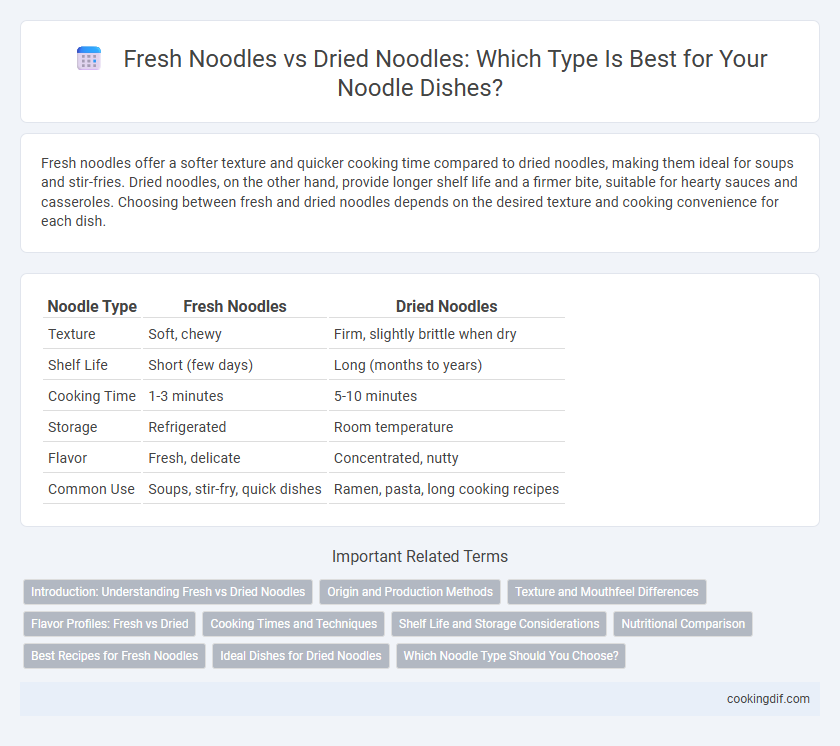Fresh noodles offer a softer texture and quicker cooking time compared to dried noodles, making them ideal for soups and stir-fries. Dried noodles, on the other hand, provide longer shelf life and a firmer bite, suitable for hearty sauces and casseroles. Choosing between fresh and dried noodles depends on the desired texture and cooking convenience for each dish.
Table of Comparison
| Noodle Type | Fresh Noodles | Dried Noodles |
|---|---|---|
| Texture | Soft, chewy | Firm, slightly brittle when dry |
| Shelf Life | Short (few days) | Long (months to years) |
| Cooking Time | 1-3 minutes | 5-10 minutes |
| Storage | Refrigerated | Room temperature |
| Flavor | Fresh, delicate | Concentrated, nutty |
| Common Use | Soups, stir-fry, quick dishes | Ramen, pasta, long cooking recipes |
Introduction: Understanding Fresh vs Dried Noodles
Fresh noodles contain higher moisture content, resulting in a softer texture and shorter cooking time compared to dried noodles, which undergo dehydration to extend shelf life and develop a firmer bite. Nutritionally, fresh noodles often retain more natural flavor and nutrients, while dried noodles provide convenience and longer storage options. Key noodle types such as ramen, udon, and egg noodles are available in both fresh and dried forms, catering to diverse culinary applications and taste preferences.
Origin and Production Methods
Fresh noodles originate primarily from East Asian cuisines and are made by mixing wheat flour with water and sometimes eggs, resulting in a soft texture due to their high moisture content. Dried noodles undergo a dehydration process through air-drying or frying, which extends shelf life and makes them more portable, common in both Asian and Western culinary traditions. The production methods influence texture and cooking time, with fresh noodles offering a tender bite and dried noodles providing a firmer, chewier experience after rehydration.
Texture and Mouthfeel Differences
Fresh noodles offer a tender, chewy texture with a moist mouthfeel that enhances the eating experience, while dried noodles tend to be firmer and denser after cooking. The moisture content in fresh noodles allows for a smoother bite, contributing to a delicate elasticity and softness not typically found in dried varieties. Dried noodles develop a slightly tougher texture that holds up well in soups and stir-fries, providing a more resilient chew.
Flavor Profiles: Fresh vs Dried
Fresh noodles deliver a tender texture with a subtle, slightly sweet flavor that enhances the sauce and ingredients they accompany. Dried noodles offer a denser bite and a more concentrated wheat taste due to the dehydration process, intensifying their overall flavor profile. Choosing between fresh and dried noodles can significantly influence the taste and mouthfeel of dishes like ramen, lo mein, and pho.
Cooking Times and Techniques
Fresh noodles require significantly shorter cooking times, typically boiling for 2-4 minutes, making them ideal for quick meals and stir-fries. Dried noodles need longer cooking, usually 8-12 minutes, and often benefit from soaking before boiling to ensure even texture and prevent brittleness. Techniques such as blanching fresh noodles help maintain their tender texture, while rinsing dried noodles post-cooking removes excess starch and improves chewiness.
Shelf Life and Storage Considerations
Fresh noodles typically have a shelf life of 1 to 2 weeks when refrigerated at 1-4degC due to higher moisture content, requiring airtight packaging to prevent spoilage. Dried noodles, with moisture below 12%, offer a significantly longer shelf life of up to 12 months at room temperature, making them ideal for extended storage without refrigeration. Proper storage conditions directly affect noodle quality and safety, where fresh noodles demand cold storage, while dried noodles benefit from a cool, dry environment to maintain texture and flavor.
Nutritional Comparison
Fresh noodles typically contain higher moisture content and retain more vitamins like B-complex and minerals compared to dried noodles, which undergo a dehydration process that can reduce nutrient levels. Dried noodles offer longer shelf life but may have slightly lower amounts of protein and fiber due to processing. Both types provide essential carbohydrates for energy, but fresh noodles often deliver a better nutritional profile with fewer preservatives and additives.
Best Recipes for Fresh Noodles
Fresh noodles offer a tender texture and absorb flavors more effectively than dried noodles, making them ideal for delicate broths and light sauces. Recipes featuring fresh noodles often highlight dishes like hand-pulled noodle soup, stir-fried fresh egg noodles with vegetables, and fresh pasta with basil pesto. Their pliability and quick cooking time enhance dishes such as ramen, pad thai, and wonton soup, showcasing the superior taste and texture of fresh over dried varieties.
Ideal Dishes for Dried Noodles
Dried noodles excel in dishes requiring firm texture and longer cooking times, such as hearty soups, stir-fries, and baked noodle casseroles. Their low moisture content enhances shelf life, making them ideal for pantry storage and quick meal preparation. Popular dishes like ramen, lo mein, and pad thai often utilize dried noodles for their ability to absorb sauces and retain chewiness.
Which Noodle Type Should You Choose?
Fresh noodles offer a soft texture and quicker cooking time, making them ideal for delicate dishes like stir-fries and soups. Dried noodles provide longer shelf life and firmer consistency, preferred in hearty recipes such as stews and pasta salads. Choosing between fresh and dried noodles depends on the desired texture, cooking time, and recipe requirements.
Fresh noodles vs dried noodles for noodle type Infographic

 cookingdif.com
cookingdif.com